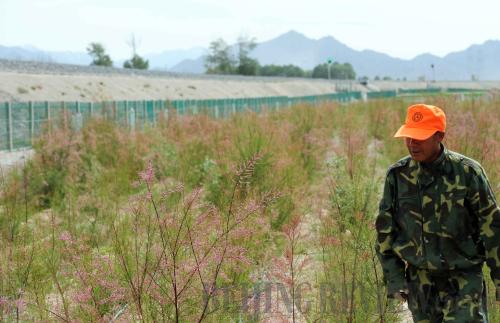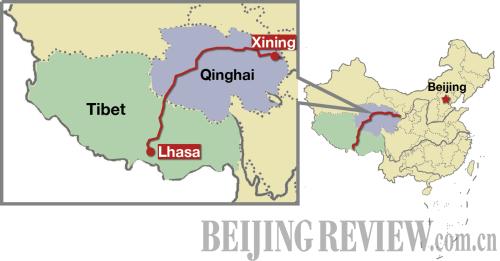|
 |
|
GREEN BELT: A worker passes by a green belt along the Qinghai-Tibet Railway on June 13, 2009 (HOU DEQIANG) |
Gradual adaptation
"In 2003, when railroad construction in the Hoh Xil Nature Reserve began, 75 percent of Tibetan antelopes failed to migrate to their traditional breeding ground; yet over the years, they have gradually adapted to the passages along the railway," Yang said.
Yang found by 2004, most antelopes managed to migrate to their summer breeding ground. He observed more than 1,600 pregnant antelopes going to the breeding ground, and 2,300 returning after birth. "Not every mother and calf survive the migration," Yang said.
On their return, Yang found approximately 96 percent of the antelopes used the passages.
Yang's team then improved the passages' design and in 2005, he saw about 98 percent of migrating antelopes using the passages.
In 2006, 2,952 antelopes returned from their breeding ground, with 98.17 percent using the passages, Yang said in a 2008 letter to the UK-based Nature magazine.
After monitoring antelopes crossing the Qinghai-Tibet Railway between 2004 and 2006, Yang's findings were confirmed by researchers from the Shaanxi Institute of Zoology.
Researchers at the institute found, in 2004, Tibetan antelopes gathered near the passages and hesitated for one to two days before attempting to get through. But in 2005, most antelopes went over after hesitating for only half a day. On June 20, 2005, researchers found it only took a herd of 310 antelopes 11 minutes to go through a passage in the Hoh Xil Nature Reserve.
The success in balancing the antelopes' welfare with the construction of a massive railway has inspired designers of other large projects in China.
Builders of a railway between Yichang City in central China's Hubei Province and Wanzhou District in Chongqing Municipality in southwest China initially planned a tunnel through the Yangtze River but later replaced it with a bridge, in order to avoid damaging the breeding grounds of the Chinese sturgeon, a highly endangered species of fish.
Greater efforts
"Since the Qinghai-Tibet Railway went into full operation, we have never slackened our environment protection efforts," said Wang Zhiwei, a manager in the Yufeng Railroad Maintenance Co., a subsidiary of the Qinghai-Tibet Railway Co. that is responsible for maintaining the section of railway between Golmud in Qinghai to Lhasa in Tibet.
"All passenger trains running along the railway are equipped with compressed garbage and sewage collection systems. The waste collected is shipped to treatment stations in nearby cities," said Liu Lijun, former head of a train crew working on the Qinghai-Tibet Railway.
"Fifteen sewage water treatment stations have been built along the stretch of railway between Golmud and Lhasa and the stations are monitored regularly to ensure the treated water meets required standards," Wang said. To reduce air pollution, the stations use solar power for heating and lighting.
"In the past five years, railroad maintenance companies have also planted vegetation wherever appropriate along the Qinghai-Tibet Railway. Now the 'greened' area, which runs along 675 km, or 31 percent of the railway, totals 5.6 million square meters," Wang said.
"Even when the railway was under construction, measures were taken to protect the area's fragile eco-system. When tracks were laid, the turf was cut into pieces and moved to another area, where vegetation was extracted for replanting," Yang said.
Experts say the vegetation coverage rate in Hoh Xil has increased from less than 15 percent in 2003 to nearly 30 percent now.
"The railway is truly a green route," Xiao said. "Since it went into operation in 2006, it has not created any environmental crisis."
In 2008, the Qinghai-Tibet Railway won a national award for being environment friendly.

Qinghai-Tibet Railway
The 1,956-km Qinghai-Tibet Railway, the world's highest and longest plateau railroad, starts from Xining, capital of Qinghai Province, and ends in Lhasa, capital of Tibet Autonomous Region. It is the first direct rail link to Tibet.
Since it went into operation one year ahead of schedule on July 1, 2006, the railway has transported more than 41 million passengers and 180 million tons of cargo.
The railway has proven effective in boosting economic development in Qinghai and Tibet. Official figures show Qinghai's GDP soared from 64.1 billion yuan ($10.04 billion) in 2006 to 134.2 billion yuan ($21.01 billion) last year. Tibet's GDP rose from 34.2 billion yuan ($5.36 billion) to 50 billion yuan ($7.83 billion), an average annual growth of at least 10 percent.
(Source: Xinhua News Agency) | 